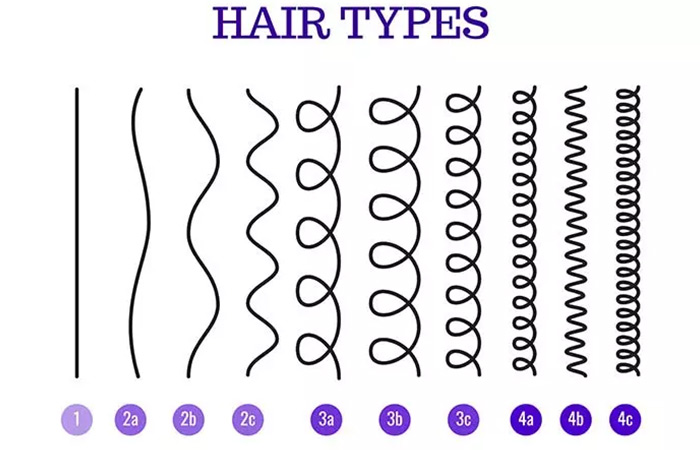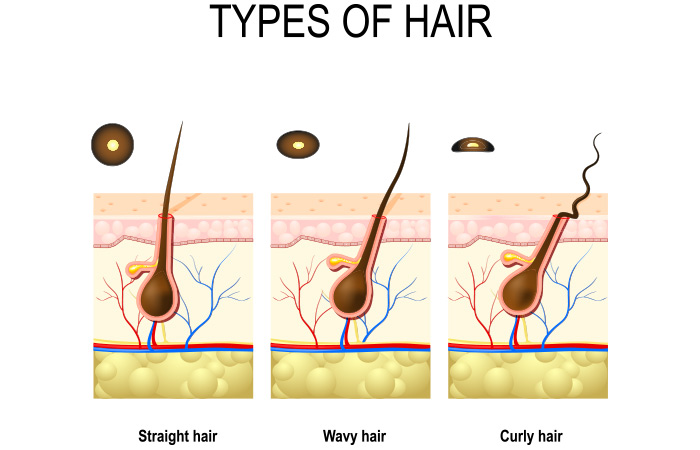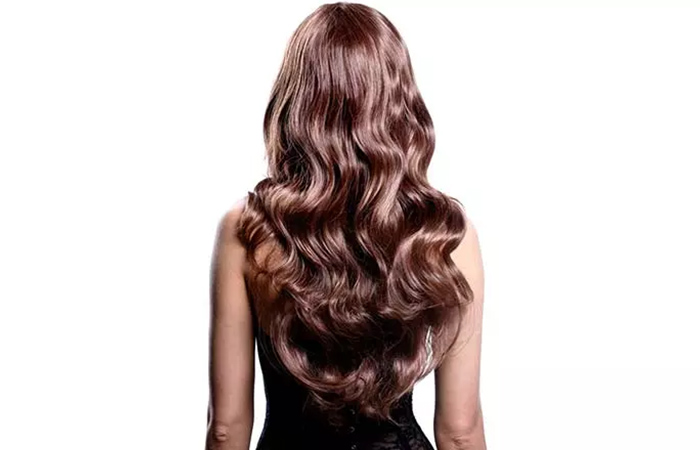how to know what type of hair i have
Well-nigh ofttimes, we end upwardly choosing the incorrect pilus care products for our pilus because we practise not know our hair type. In this commodity, you can acquire how to determine your hair blazon to accept better care of your hair. This tin help you lot style your hair better. The pilus type is characterized by multiple factors such equally porosity, density, thickness, and elasticity. Keep reading to learn in detail about the different types of hair. Once you nothing in on your hair type, yous can cull the right hair styling techniques and pilus care products. Scroll down to become your #hairgoals.
1. Pilus Density
Your hair density pertains to how much hair (the number of individual strands) y'all accept on your scalp. Hair density differs from hair diameter. Y'all can have thin pilus with more than density, and vice versa. At that place are iii levels of hair density, any of which tin be determined with the mirror examination.
Grab a large section of your hair and pull it bated. The extent to which y'all can see your scalp determines your hair density.
- Sparse Density: If you can easily see your scalp, you have thin hair density. That means your hair is scantily placed.
- Medium Density: If yous tin see your scalp partially from underneath your hair, you have medium hair density.
- Thick Density: If y'all can inappreciably come across your scalp, you take thick pilus density.
2. Hair Bore
The diameter of your hair refers to the width of an individual hair strand. This is the well-nigh authentic manner to determine your pilus blazon. Practice the strand test to sympathise if your hair is fine, medium or thick.
Hold a single strand of your pilus between your pollex and index fingers.
- Sparse Pilus: If you tin barely feel the strand betwixt your fingers, you have thin hair. In some cases, the hair strand tin be so sparse that it is not even visible.
- Medium Hair: If yous can feel the hair strand slightly, you have medium hair.
- Thick Pilus: If you can distinctly feel the hair strand, you have thick hair.
You tin also compare your pilus strand to a sewing thread. Place a hair strand along the length of a thread. If information technology is just as thick or fifty-fifty thicker than the thread, you have coarse or thick hair. If it is more or less the same thickness as the thread, you have medium hair. If the hair strand is significantly thinner than the thread, y'all have thin or limp hair.
iii. Porosity
Porosity refers to your hair's ability to absorb and retain moisture. The college the porosity, the more moisture and production it will blot. Loftier porosity may cause impairment to hair (1). This besides extends to its ability to absorb products.
Knowing the porosity of your hair can exist helpful in choosing the right products for your hair. Submerge a single hair strand in a cup of water to determine the level of hair porosity.
- Loftier Porosity: If the hair strand sinks to the bottom, you have high pilus porosity. Hair with high porosity is more than decumbent to impairment every bit it can readily absorb the chemicals from products. It also gets frizzy and rough easily. Your pilus may besides dry up quickly after you lot wash it. A high number of pores in the pilus cuticle results in loftier porosity. Information technology is often caused due to frequent awarding of chemical-filled products or treatments. When you have highly porous hair, it is never hydrated enough.
- Medium O r Normal Porosity: You can find the strand floating in between the water and rightly balanced if your has normal porosity. This hair type takes in the right amount of wet. Afterwards washing it, your hair feels wet, but not sticky. It does not crave a lot of maintenance and tin hold any hairstyle effortlessly. Hair with normal porosity is less prone to impairment.
- Low Porosity: If you accept depression porosity, your hair strand will float on the surface. This ways, your hair takes a long time to dry. Your hair cuticles have fewer pores, which minimize your pilus'due south capacity to absorb water. The water tends to remain on the surface of the cuticle, and products used oftentimes get settled on top of your hair rather than sinking in. Afterwards a hair wash, your hair stays wet for long hours and feels gummy.
four. Pilus Greasiness
Knowing how greasy your hair is can help yous understand how frequently you need to wash it. You will also be able to pick the correct products, like clarifying shampoos and conditioners, every bit oily hair tends to build residual faster.
Wash your hair thoroughly before hitting the bed and allow information technology air dry out. One time you lot wake upwards, do a patch exam on your scalp. You can printing a tissue against your scalp, especially nigh the crown of your head and backside your ears. The amount of oil deposited on the tissue volition decide how oily your pilus is.
- Oily Hair: If there is a heavily greasy patch on the tissue, you have greasy hair and scalp. This means you need to wash your hair 4 to 5 times a calendar week.
- Normal Hair: If there is very light evidence of oil, you have a normal scalp. You can wash your hair ane to 2 times a calendar week.
- Dry Hair: At that place is no oil deposited on the tissue. This indicates a lack of hydration. Utilize products that can add and retain wet in your locks.
- Combination Hair: If there is oil deposited on the tissue from simply specific regions of your scalp, information technology indicates combination hair. Often, the hair behind your ears and over the temples secretes a high amount of oil.
Sometimes, individuals can have an oily scalp with dry and frizzy pilus. Such people should use an oily scalp shampoo for the scalp and shampoo for dry out hair on their strands. They can also simply shampoo the scalp more than frequently or utilise a conditioner on their hair without shampooing every time.
Most of the times, people mistake dandruff or flakes to be arising out of dry scalp and continue using wrong products. This tin worsen the condition and pb to pilus loss. Hence, if your condition does non improve with the usage of the OTC product, you must consult an expert instead of but irresolute your hair care products.
v. Hair Elasticity
Pilus elasticity refers to the extent to which a single hair strand can stretch before returning to its normal state (1). It is a strong indicator of pilus health. Hair with high elasticity has a proficient amount of smooth and bounciness and is regarded as the strongest of all pilus types.
To observe out the elasticity of your hair, you lot need to pluck a moisture hair strand and stretch it as much every bit you can. Depending on the results, your hair elasticity tin exist categorized into one of 3 types.
- High Elasticity: If your hair strand stretches a long fashion without breaking immediately, it indicates loftier elasticity. This means stronger hair. Hair with loftier elasticity (when wet) tin stretch upward to 50% of its original length before it breaks. Oftentimes, fibroid hair is highly rubberband.
- Medium Elasticity: If your hair stretches to some extent before breaking, it indicates medium elasticity. Near women take medium pilus elasticity. You can strengthen your hair using natural hair masks and pilus oils.
- Low Elasticity: Hair that snaps almost immediately after stretching has low elasticity.
This pilus type tends to be limp and breakable. It requires special attention with respect to the products used on it. Harsh chemicals can diminish pilus elasticity. Hence, it is essential to choose shampoos that strengthen pilus cuticles.
6. Ringlet Design
Shutterstock
Observe your hair. Is information technology curly, wavy, straight, or kinky? There are four types of hair patterns. Your hair follicle and hair shaft decide how your hair will look. The tilt of the hair follicle and the manner it grows into the scalp decide your hair blueprint.
Shutterstock
In the post-obit section, we will look at the different hair types. Endeavor identifying which of these define you.
Type one: Straight Hair
Shutterstock
This hair type stays straight irrespective of any amount of curling (2). It typically lies flat from the roots to the tips. Its texture is soft and silky, and information technology is extremely shiny. It does not possess any curls. Often, women with directly hair have fine hair. Besides existence soft, you tin can likewise see a loftier amount of oil secretion in this naturally straight hair blazon.
Type ii: Wavy Hair
Shutterstock
Wavy hair type is neither straight nor curly. It falls somewhere between the two. In wavy hair, you can detect a slight curl blueprint at the lower terminate of your pilus (3). It can hold hairstyles very well. Its texture is quite rough, and its diameter is thick. Type ii is divided into three sub-types:
- 2A is thin wavy hair
- 2B is medium wavy pilus
- 2C is thick wavy hair
Type three: Curly Hair
Shutterstock
The all-time mode to determine if you accept blazon 3 curls is to cheque if your hair strand follows an 'Due south' pattern (3). This pilus type has definite curls that stay curly irrespective of whatsoever amount of straightening. It has higher density compared to wavy and straight hair. Information technology is more prone to frizz and can get tangled quickly. Blazon iii is again divided into three sub-types:
- Type 3A has loose curls
- Type 3B has medium curls
- Blazon 3C has tight curls
Blazon 4: Kinky Hair
Shutterstock
Kinky hair looks coarse and rough but is actually quite fragile and soft. It is easily prone to breakage and damage if not cared for. Kinky hair has loftier density with extremely tight curls. The curls resemble a 'Z' shape (iii). This pilus type is divided into three sub-types:
- Type 4A is soft
- Type 4B is wiry
- Type 4C is extremely wiry
Knowing your hair blazon is the cardinal to unlocking healthy hair! Pilus diameter, porosity, greasiness, elasticity, density, and pattern help you determine your hair type. At that place are four main hair types: straight, wavy, curly, and coily. As you lot understand your pilus type better, you lot will larn to cater to the right hair bug. Not only that, but knowing your pilus type allows you lot to cull the right hair products for your hair, similar serums, shampoos, masks, and brushes. Yous can at present devise a hair care routine that can attend and improve your hair type.
Practiced'southward Answers For Readers' Questions
Practise I have 1B hair?
Type 1B hair has the ability to hold curls effectively. Also, it has a medium texture and is generally directly from the roots. If this description matches your hair, you take 1B hair.
What does 1B hair type look like?
1B pilus blazon looks shiny and sleek. It has subtle bends in the middle just ends in gentle curls.
Is my hair 1C or 2A?
Type 1C pilus is straight simply easily holds a slight curlicue. This pilus type can easily reach a tousled wait when y'all air-dry it. 2A hair is voluminous and wavier than type 1 hair. You can figure out your hair type based on these descriptions.
Was this article helpful?
The following 2 tabs alter content below.
-
Author
- Reviewer

Arshiya Syeda is an editor at Stylecraze. Prior to that, she was a content writer and combined her writing and... more

Dr. Rekha Yadav is a certified trichologist from the International Association of Trichologists, Commonwealth of australia. She established her hair and scalp... more than
Source: https://www.stylecraze.com/articles/how-to-determine-your-hair-type/






0 Response to "how to know what type of hair i have"
Post a Comment